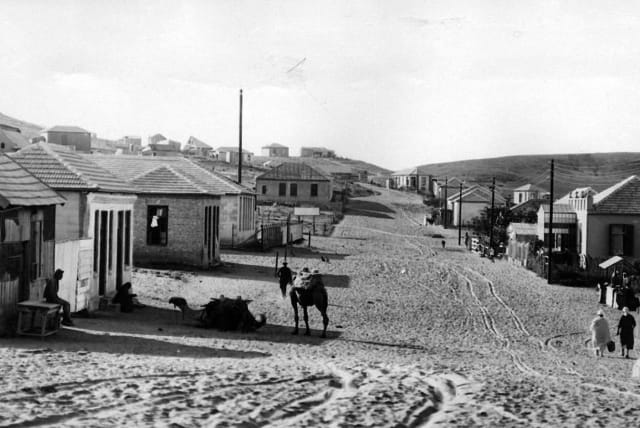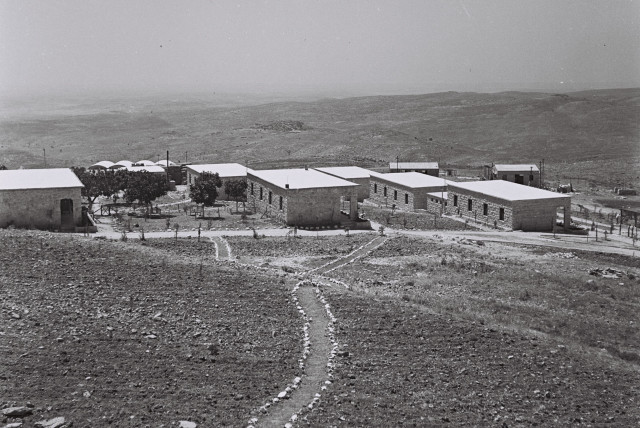When UK rabbis realized hassidim drained the swamps of pre-state Israel

Seeing such people tilling the land, draining marshes, and sweating under the sun was a sure sign of the coming redemption for the rabbis of the United Kingdom.
In Elul – that is, August-September – 1926, a pamphlet titled “The Rebuilding of Palestine: Appeal by the Rabbonim of the United Kingdom” was published in London. The pamphlet was eight pages long – four pages in English and four in Yiddish – and was signed by 28 rabbis.
The first signatories were the rabbinic heads of three synagogue organizations:
“The Appeal is signed by the Very Reverend the Chief Rabbi Dr. J. H. HERTZ, on behalf of the Beth-Din; GAGUINE, S. Rabbi Ab-Beth-Din, Spanish and Portugese [sic] Jewish Congregation; CHAIKIN, A. Dayan Chief Minister, Federation of Synagogues.”
The rest of the signatories were then listed in alphabetic order. In addition to London rabbis, the list of signatories included rabbis from Belfast, Birmingham, Dublin, Edinburgh, Gateshead, Glasgow, Leeds, Liverpool, Newcastle-on-Tyne, Manchester, Middlesbrough, Sheffield, Sunderland, and Wallasey. One name – Rabbi Joel Sussman Hodes (1869-1961) from Birmingham – only appeared in the Yiddish, most probably an accidental omission from the English. Two of the signatories would go on to be chief rabbis of the State of Israel: “HERZOG, I. M.A. D. Litt., Dr. Rabbi Dublin” and “UNTERMAN, I. J. Rabbi Ab-Beth-Din, Liverpool.”
The pamphlet called on British Jews to realize “the greatness of the era”:
“At last we are privileged to see in our own time the Light of Salvation. And if we have not yet attained complete redemption, if we do not yet behold the era as foretold by our ancient sages in their expositions of the words of the Prophets, we have, nevertheless, reached a time that may be described as the beginning of the Messianic epoch.”
The messianic epoch
The pamphlet continued, listing various events that signaled the messianic epoch. This included the many people who settled in the Land of Israel; the yeshivot of Poland and Lithuania that had migrated to the holy city; the “conscience of the nations” as indicated by the Balfour Declaration and the Mandate for Palestine; and the heroic pioneers who were tilling the land.
Moreover, “We have even witnessed the wonderful phenomenon of hassidim with their rabbis, working among the halutzim, performing the hard work of draining the marshes and colonizing the land with the same fervor and enthusiasm with which they perform their religious duties.”
For British Jews, Hassidim plowing and hoeing was a sight to behold, a sign of redemption. Indeed, in the parallel Yiddish version, the words “hassidim with their rabbis” were the only words that were spaced out to give added emphasis.
WHICH HASSIDIM might the rabbinic leaders in the United Kingdom have had in mind?
Hassidim had been in the Land of Israel since the 18th century. Famously, a large cohort of 300 hassidic affiliates made aliyah in 1777, increasing the Jewish population by 5%. However, these Hassidim were not renowned for their agricultural efforts.
It could well have been that the UK rabbis were looking at Bnei Brak, a small agricultural settlement that was established by Polish hassidic families who had made aliyah between the years 1924 and 1928. Indeed, in 1926, the Bnei Brak Hassidim were busy working the land in a bid to grow citrus fruit.
Or perhaps the UK rabbis were looking farther north to Kfar Hassidim, which was also founded in 1924, by two groups of Hassidim from Poland. One group was led by the rebbe from Kozienice, Rabbi Yisrael Elazar Hopsztajn (1898-1966), and was called Avodat Yisrael, “toil of Israel” – the title of one of the books of the founder of Kozienice Hassidism and a name that carried multiple meanings: service of God, cultivating the Land of Israel, and a throwback to the group’s saintly spiritual predecessor.
A second group was led by the rebbe of Jabłonna, Rabbi Yehezkel Taub (1895-1986), and was called Nahalat Yaakov, “the heritage of Jacob.” Other hassidic masters also contributed to the initiative: Rabbi Avraham Yaakov Shapira of Drohobycz (1886-1962), who had moved to the British Mandate of Palestine in 1922; and Rabbi Avraham Elimelekh Shapira of Grodzisk Mazowiecki (1894-1966).
In 1926, the Jewish National Fund decided that Avodat Yisrael and Nahalat Yaakov should join forces. A third group was added from Hapoel HaMizrachi – the Religious-Zionist organization and political party that supported religious kibbutzim and moshavim. Hapoel HaMizrachi had been formed by religious Labor Zionists, including Rabbi Yeshaya Shapira (1891-1945), known as the Ha’admor He’halutz, “the pioneering hassidic master.” The moshav was renamed Kfar Hassidim, “the village of the Hassidim.” The first challenge these hassidic farmers faced was draining the Galilee swamplands.
WHETHER IT was the Hassidim of Bnei Brak, the Hassidim of Kfar Hassidim, or some other group, seeing such people tilling the land, draining marshes, and sweating under the sun was a sure sign of the coming redemption for the rabbis of the United Kingdom. It was a reason to call on Jews of His Majesty’s realm to support the cause:
“The time has now come to build up our land. We appeal to our fellow Jews in Great Britain, which was the first country to assist us in establishing our national home in Eretz Israel.... The time has come when the Jews of England must be among the first to participate in the great mitzvah of the resettlement of the Land of Israel... for if not now, at this juncture, when then?”
Sensitive to divisions among factions, the pamphlet pointed out that this cause “is independent of religious differences. All can and should join.” And warning: “If we neglect this duty, future generations of our people will not forgive us.”
The signatories concluded with a call for unity:
“[W]e appeal to you to unite, with one will and one mind, in the task of helping to the utmost in the upbuilding of the land of our fathers, our heritage of old, as Eretz Israel.” ■
The writer is a senior faculty member at the Pardes Institute of Jewish Studies and rabbi in Tzur Hadassah.
Jerusalem Post Store
`; document.getElementById("linkPremium").innerHTML = cont; var divWithLink = document.getElementById("premium-link"); if (divWithLink !== null && divWithLink !== 'undefined') { divWithLink.style.border = "solid 1px #cb0f3e"; divWithLink.style.textAlign = "center"; divWithLink.style.marginBottom = "15px"; divWithLink.style.marginTop = "15px"; divWithLink.style.width = "100%"; divWithLink.style.backgroundColor = "#122952"; divWithLink.style.color = "#ffffff"; divWithLink.style.lineHeight = "1.5"; } } (function (v, i) { });

